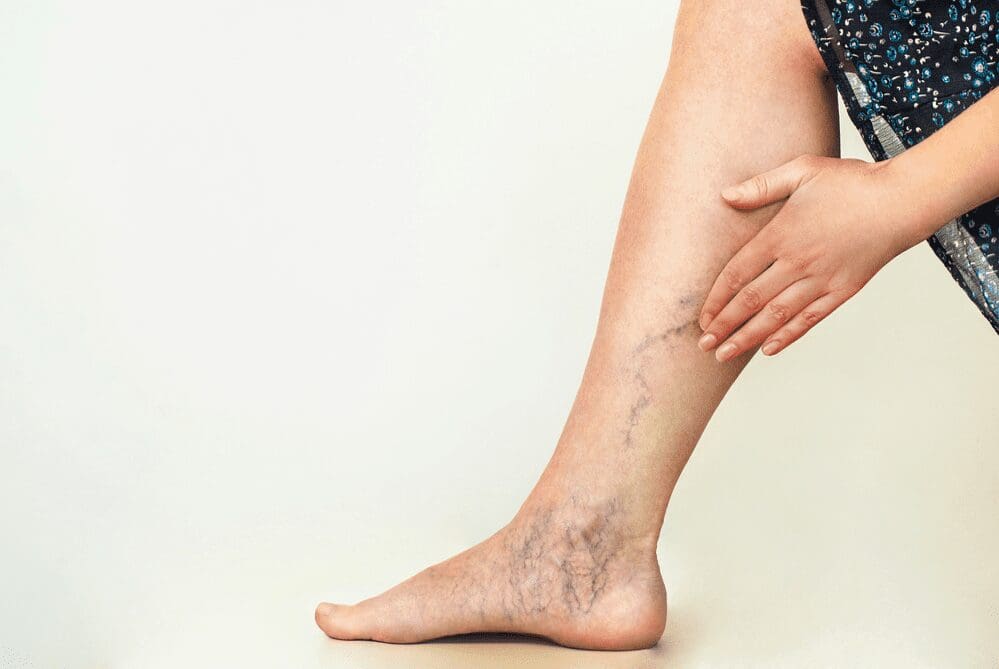At North Texas Vein and Vascular, we understand that varicose veins can significantly affect your quality of life. That’s why we offer radiofrequency ablation (RFA), a minimally invasive procedure that can help eliminate varicose veins without surgery. Dr. Handley performs RFA in our Flower Mound, TX, clinic using the latest technology to ensure the best possible outcome for our patients.
Who Is a Good Candidate for Radiofrequency Ablation?
Radiofrequency ablation, also known as RF ablation or simply RFA, is a minimally invasive procedure used to treat many medical conditions, including but not limited to benign and malignant tumors, chronic back and neck pain, and chronic venous insufficiency.
We use RF ablation at North Texas Vein and Vascular to treat venous insufficiency, a common condition affecting the legs. This condition can result in varicose veins, which can be painful and uncomfortable. By undergoing RF ablation, patients can experience significant relief from varicose veins and achieve a better quality of life.
If you suffer from varicose veins, you could be a good candidate for RFA. We recommend scheduling a consultation with our experienced Dr. Handley to determine if RF ablation is the right treatment option for you. Our team will assess your health and provide you with all the information you need to make informed decisions regarding your treatment options.
What Is Venous Insufficiency?
Venous insufficiency is a condition where the veins in the legs cannot efficiently push blood back up toward the heart, resulting in blood pooling in the lower limbs. Vein valves are small structures inside the veins that help regulate blood flow. These valves work by opening to allow blood to flow toward the heart and closing to prevent blood from flowing back toward the legs.
When these valves fail to function properly, blood can flow back toward the legs, leading to venous insufficiency. There are several reasons why the veins may fail to work properly. One common cause is the weakening of the vein walls and valves due to factors such as age and extended periods of standing or sitting. As a result, the valves may not close properly, leading to the backflow of blood.
Three things can happen as venous insufficiency worsens. Firstly, the skin may become discolored or darkened and feel tight or itchy. Secondly, swelling can occur in the feet, ankles, and lower legs and may worsen at the end of the day. Lastly, varicose veins can form, become more visible, and cause pain or discomfort.
What Happens If Varicose Veins Go Untreated?
If left untreated, varicose veins can lead to several complications, including deep vein thrombosis (DVT), leg ulcers, and edema. Deep vein thrombosis occurs when a blood clot forms in one of the leg’s deep veins. This can be a serious condition requiring immediate medical attention. Some symptoms of DVT include leg pain, swelling, and redness.
Edema is the term for swelling caused by excess fluid trapped in the body’s tissues. When varicose veins cause edema, the surrounding tissues can become infected. This can be especially dangerous for people with weakened immune systems or other underlying health conditions.
Leg ulcers are open sores that can be difficult to treat and may take a long period to heal. These ulcers can be very painful and make walking or performing daily activities difficult. Leg ulcers can also become infected, leading to additional health problems. To avoid these complications, it’s crucial to seek treatment for varicose veins as soon as possible.
Treatment
If you’re struggling with varicose veins, several treatments are available to help manage or alleviate the discomforts you’re experiencing. These treatments include radiofrequency ablation, sclerotherapy, and laser ablation. Sclerotherapy involves the injection of a special solution into the affected veins, which causes them to close and fade away eventually.
RFA involves using radiofrequency energy to heat and collapse the diseased veins, causing them to be reabsorbed by the body eventually. This treatment is minimally invasive compared to surgery, and patients typically experience little to no downtime.
Before Treatment: 4 Preparation Tips
Wear Loose Clothing
On the day of the procedure, it is advisable to wear loose-fitting clothing that is comfortable and easy to remove. This will help you feel more relaxed during the procedure.
Prepare Mentally
It is crucial to mentally prepare yourself for the procedure, especially if you are nervous or anxious. You can do this by talking to the doctor, reading about the treatment, and asking any questions you may have. Also, consider doing relaxation exercises beforehand, such as deep breathing, to help calm your nerves.
Do Not Take Aspirin
Aspirin can cause bleeding during the procedure, so it is important to avoid taking it for at least 11 days before your appointment. Dr. Handley may also advise avoiding other blood-thinning medications, such as ibuprofen, naproxen, and warfarin, in the days leading up to your appointment.
Do Not Take Insulin or Diabetes Pills
If you have diabetes, talk to Dr. Handley about how to manage your medication before the procedure. We typically recommend not taking insulin or diabetes pills on the day of the procedure, but to resume taking them after the procedure as directed by your doctor.
By following these four steps, you can help ensure that your RFA procedure goes smoothly and that you experience the best possible outcome.
During Treatment: The Procedure
Step One
The first step is to examine the leg with ultrasound to identify the affected veins and assess their size and location.
Step Two
Once the affected veins have been identified, the area around them will be cleaned and covered with a sterile drape to minimize the risk of infection.
Step Three
EMLA™ cream (a local anesthetic cream) may be applied to the area to minimize discomfort during the procedure.
Step Four
A small sheath will then be placed into the vein under ultrasound guidance. Ultrasound imaging allows for accurate placement of the sheath, preventing the risk of complications from incorrect placement.
Step Five
Through the sheath, a radiofrequency ablation catheter is placed into the vein, also using ultrasound imaging to ensure accurate positioning.
Step Six
Once the catheter is in place, a numbing medicine, usually a dilute solution of Lidocaine, is injected around the vein.
Step Seven
RF energy is then delivered to the vein through the catheter. The heat from the RF device causes the vein to seal shut, preventing blood flow through the vein.
Step Eight
As the vein is sealed, blood reroutes to other healthy veins in the leg, reducing the symptoms of varicose veins.
Step Nine
After the procedure is complete, a steri-strip is placed at the access site, and the area may be covered with a small bandage.
After Treatment: Instructions To Follow
Wear an ACE Bandage
Dr. Handley may recommend wearing an ACE bandage over the treated area to help keep the treated veins closed. This bandage should be worn snugly, but not too tightly. Be sure to follow the doctor’s instructions on how long to wear the bandage and when to remove it.
Wear Compression Stockings
Like an ACE bandage, a compression stocking can help ensure the treated veins shut completely. The doctor may recommend wearing the stocking for a certain period each day.
Follow Doctor Instructions
It is crucial that you follow specific instructions carefully after an RFA procedure. These instructions may include taking medication as prescribed.
Drink Plenty of Water
Staying hydrated is vital for overall health and can help flush out any toxins or byproducts of the procedure.
Follow-Up Appointments
Scheduling and attending all follow-up appointments allows the doctor to monitor your progress and make any necessary adjustments to your treatment plan. Be sure to ask any questions or raise any concerns you may have during these appointments.
How Long Does RFA for Varicose Veins Take?
The procedure is typically performed on an outpatient basis and usually takes less than an hour to complete. While the actual RFA procedure is relatively quick, you should arrive early for your appointment to allow time for preparation and to ensure that any questions or concerns you have are addressed beforehand.
Schedule Your Initial Consultation Today
If you suffer from varicose veins and want to learn more about the benefits of radiofrequency ablation, call North Texas Vein and Vascular in Flower Mound, TX, today to schedule an initial consultation. During your appointment, we will assess your needs and determine whether RFA is the right treatment for your case.

